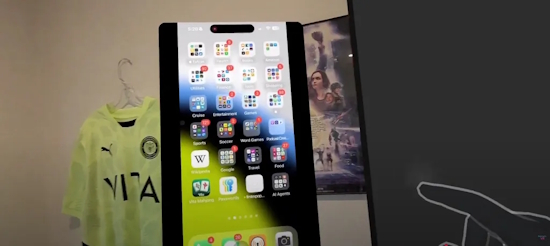[While virtual (and even mixed) reality can evoke and extend presence experiences by isolating the user from their location in the real (nonmediated) world, a common complaint is that the need or desire to return to real world activities typically ‘breaks’ presence. As the UploadVR story below reports, a new app for Meta Quest headsets addresses the complaint by making it possible to interact with one’s phone (ironically, another medium), without having to exit a virtual environment. See the original version of the story for a 21-second embedded video and a second 1:40 minute video (also available on YouTube). –Matthew]

[Image: Screen capture using Spatial Phone in Mixed Reality with hand tracking. Image by Craig Storm captured on Quest 3.]
Spatial Phone Lets You Use Your iPhone Or Android While Immersed On Quest
You can see and control your iPhone or Android in Quest with the $12 Spatial Phone app, though with noticeable latency.
By Craig Storm
August 18, 2025
One of the most frustrating things about VR is how cut off it can feel. You’re in the zone, working out, playing, meditating, or just hanging out in a virtual space. Say a text comes in on your phone, or you need to check something else on the device sitting right next to you. Until recently, the easiest option was to take off the headset, unlock your phone, and lose the flow.
Spatial Phone tries to fix that with some workarounds, and tradeoffs.
Created by developer Gulzar Ahmed, Spatial Phone is a lightweight app for Quest that mirrors your actual phone screen inside VR as a multitasking window. It launched with support for Android, and now works with iPhone too.
The setup is quick. You install the app on your Quest, grab the companion app for your phone, open both, and pair them using a short code. Once connected, your phone screen floats beside you in VR or mixed reality.
The stream broadcasting from the iPhone isn’t razor sharp, but it’s clear enough to read messages or check notifications. There is significant latency, but for the occasional glance at an incoming notification it does what it needs to do.
Spatial Phone quietly floats in the background. You can move it, resize it, or ignore it while staying fully present in whatever app you’re already using, making it useful for longer sessions where you just want your phone nearby without breaking immersion.
A recent update added something even more interesting. iPhone users can enable Bluetooth control, which turns the Quest into a kind of virtual remote. Once paired, you can navigate your iPhone with a VR controller in hand by triggering AssistiveTouch in the iOS accessibility settings. It takes a few extra steps to enable, but once it’s set up, you can tap and swipe across a flat floating virtual interface to control the phone without physically touching the device. The feature is fairly cumbersome at present, yet still the most functional hands-free iPhone integration available on Quest.
Support for Android devices on Apple Vision Pro is on the roadmap as well, according to Ahmed.
Spatial Phone isn’t flashy but addresses a problem most headset and phone makers haven’t worked out yet. Some services, like Immersed, added phone streaming as well inside of their multipurpose apps, while Motorola released a more streamlined screen mirror feature for Quest, but only for their phones. For everyone else, this may be the most straightforward way to bring your phone into VR, at least for now.
You can find Spatial Phone on the Meta Horizon Store for $12.
Leave a Reply